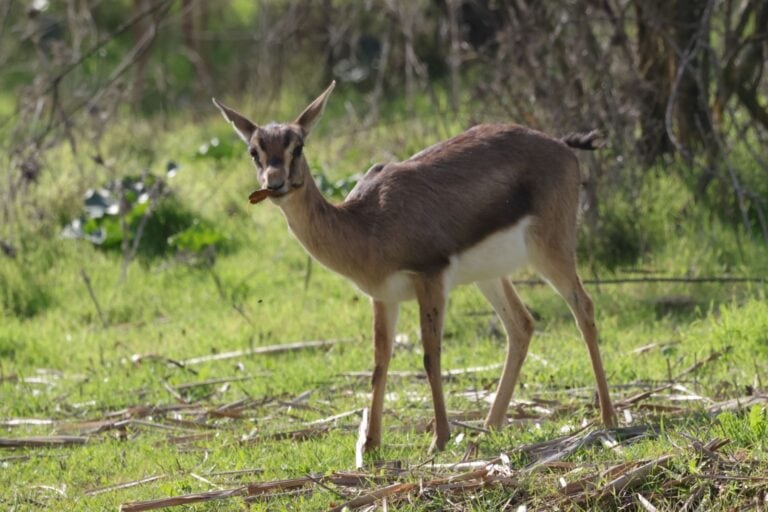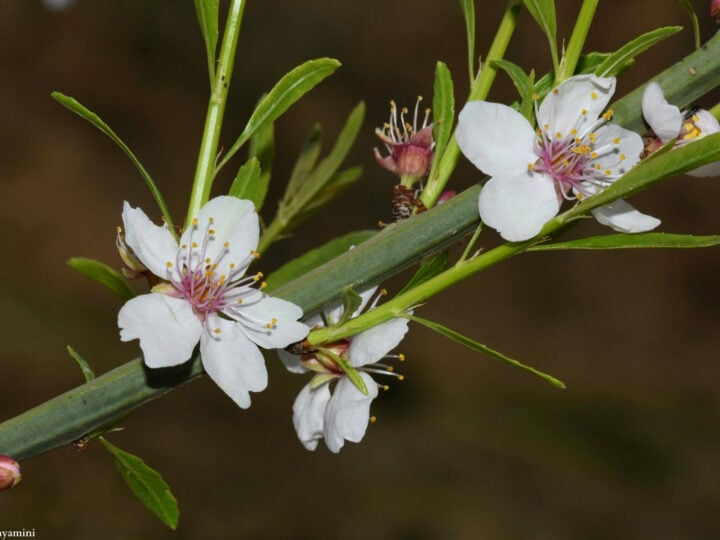The first appearance of pretty pink almond blossoms is always associated with Tu B’Shvat (the 15th of Shvat on the Hebrew calendar), a holiday often called the Jewish new year for trees.
This year, Tu B’Shvat falls out on January 25.
But already by the end of December almond trees started blooming in various parts of Israel, said Yael Zilberstein-Barzida, director of the Urban Nature Unit of the Society for the Protection of Nature in Israel (SPNI).
She explained that early flowering is caused by this season’s erratic weather patterns, including “sharp transitions between cold winter days and sunny and warm [winter] days. The warm temperatures trigger the mechanisms of the fragrant and colorful flowering designed to attract pollinators.”
Even wild cyclamens, usually a February arrival, are beginning to bloom in January.

Though blossoms do look lovely in winter, the sharp transitions that cause them are a not-so-lovely result of climate change.
One of warmest winters ever
“In Israel, 2023 was one of the three warmest years since 1950,” says Assaf Hochman, an assistant professor at the Hebrew University of Jerusalem’s Institute of Earth Sciences and its Predictability of Extreme Weather lab.
“November and December were characterized by a low number of precipitation days but with unusual intensities,” he tells ISRAEL21c. “This is also why we had quite a few floods.”
Hochman’s forecasts and climate-change models indicate a continued warm winter this year and in the coming years.
“Our main projection is that seasonality will change. We expect the winter to be shorter — two or three months, not six months — and autumn, spring and summer to be longer,” he says.
Last April, Hochman and German colleagues published a study predicting that the Eastern Mediterranean region will experience a sevenfold increase in extreme heatwaves by the end of the 21st century.
The implications go way beyond almond trees. Every aspect of our natural environment, from microbes to reptiles, will increasingly be affected by these changes.
Hochman says the Mediterranean region is a climate-change hotspot, and especially Israel as it encompasses temperate wetter weather in the north and desert dryness in the south.
Imbalances, insects, illness
Amir Balaban, head of SPNI’s Urban Wildlife Initiative, says that most creatures and plants, even bacteria, can adapt to erratic weather “unless it’s too severe for them to handle.”
“There will be winners and losers. Some big wild animals will endure and others will go extinct. The species that will prevail are those that have the ability to adapt and deal with extreme erratic conditions such as cold and hot spells and flooding.”
Moving from winters that were consistently cold for three or four months to cold spells and warm spells one after the other, he adds, “is affecting the balance and stability of nature. For any aspect of life to develop well, stability is a very important factor.”
He is concerned to see that insects such as mosquitos are still flying around in January. Some can be carrying zoonotic diseases — infections that spread from animals to people — such as leishmania and West Nile virus.

Hochman explains that insects are influenced by large-scale weather circulation patterns.
Under warmer conditions, changes in these patterns could mean, for example, new types of insects coming to the region and mosquitos being a pesky nuisance for a longer period of time.
As for common winter illnesses, Hochman says that the literature indicates that generally warmer temps, extreme weather events and variability from very warm to very cold situations can help viruses and other microbes flourish.
“But it depends on the virus. Flu viruses, for instance, needs colder temperatures, so if the winter is warmer we might expect less flu although we don’t see a big change yet. Other viruses might flourish in warmer, more humid conditions,” says Hochman.
Gazelles yes, reptiles no
Balaban observes that some animals are positively affected by warm spells.
Israel’s mountain gazelles, for instance, like moderate weather and are thriving during this mild winter from the sand dunes of the western Negev to the usually chilly northern Mount Hermon.
“This is an example of a mammal that has a good chance against climate change,” says Balaban.

Others aren’t faring as well.
“In December, we started getting a lot of reports of Palestinian vipers out and about, which usually happens in March when it gets warmer,” says Balaban.
“When temperatures reach 18 [Celsius, about 64 degrees Fahrenheit], many reptiles open their eyes and feel warm air and start coming out. These awakenings could be bad because when reptiles are dormant their physiology is on ‘save’ mode. If they wake up and waste energy reserves, they might not survive the winter.”

Birds fooled by warm temps
Migratory birds are arriving in Israel earlier than usual because they incorrectly sense winter waning.
“Some will die because they migrate expecting spring, but it’s not spring yet and they will get caught in a cold spell. This is happening across the world,” says Balaban.
“There’s a blackcap bird in Jerusalem Bird Observatory’s Ariel ringing station that we’ve been monitoring for 30 years. Thirty years ago, most European blackcaps passed over Israel in the early fall and migrated to eastern Africa. We rarely saw a wintering blackcap,” he says.

“Now, climate change has caused Israel to become a wintering ground for a large population of blackcaps that changed their migration route and wintering quarters. This is partly because they learned Israel is not getting cold but probably it’s also because the long-distance migrants perished because passage over the Sahara was so harsh. Those thriving now had a shorter distance to fly.”
Meanwhile, birds from Israel’s desert areas are moving northward.
“In Jerusalem, we see the pale crag martin, a little swallow that normally lives in the desert. They find areas in the city that are like desert canyons where they can nest and find little flies to eat.”

Hardy birds like crows have a good chance at surviving an erratic winter, while more delicate species of a similar size, like turtle doves, are faring poorly, he adds.
Prediction = preparation
At the Hebrew University, Hochman’s lab is working to improve the ability to predict extreme weather as long as a month or season in advance, and to improve climate projections as much as 10 decades ahead.
“We look back in the past to get a perspective on what we see now and in the future,” he says.
Currently serving on reserve duty, Hochman points out that weather influences every aspect of our lives, even war.
“Extreme weather might be more impactful than war,” he says.
One recent paper from his lab describe the heightened impact of compound weather extremes, such as extreme precipitation and extreme winds at the same time, which provides a new perspective on how to predict in advance.
A study published last July in Nature Scientific Reports looked at extreme weather on rocky planets similar to Earth to better understand what may be in store for our own planet as greenhouse gas emissions change the climate.
“It is all about being prepared and planning accordingly,” he says.
“If extreme weather is predicted a few days from now, there’s not much to do except issue a warning. But if we know a month or a season in advance about extreme dryness or rainfall or a pandemic, governments can invest more in preparation.”

















